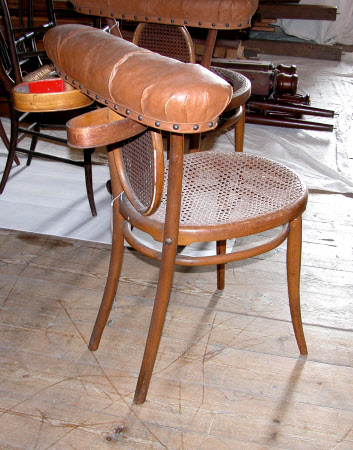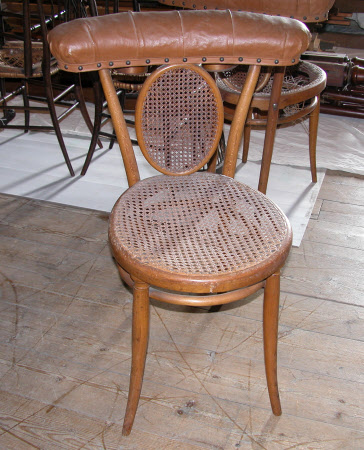Bentwood chair
Michael Thonet (1796-1871)
Category
Furniture
Date
1855 - 1865
Materials
Beech, cane, leather
Measurements
87 x 60 x 47 cm
Place of origin
Austria
Order this imageCollection
Ickworth, Suffolk
NT 850168.1
Summary
One of a pair of bentwood beech and cane chairs, by Michael Thonet, Austria, mid 19th century Sometimes known as a smoking chair. The top rail with a leather pad and two hinged pockets, one with a metal inset above an oval caned panel and seat on turned legs tied by a high loop stretcher. Bearing a paper printed label to the seat rail for Gebrüder Thonet in Wien
Full description
Michael Thonet (1796–1871) was born in Boppard am Rhein, Prussia, and trained as a traditional cabinet-maker. In the 1830s, as an alternative to the laborious technique of carving, he began bending wood to create furniture. In 1855 Thonet made a key technological breakthrough. After years of bending laminated wood, he discovered that by attaching a metal strip along its length, solid wood could be bent in a similar way. This eliminated the costly lamination process and earned patents guaranteeing a virtual monopoly on production. In 1857 Thonet built a new factory in Koritschan in the Moravian forests (in what was then Austro-Hungary) with a ready supply of beech wood, plenty of cheap labor and access to important rail links. The firm went on to mass-produce ‘bentwood’ furniture in unprecedented numbers, manufacturing up to 1.8 million pieces a year by 1912.
Provenance
Part of the Bristol Collection. Acquired by the National Trust in 1956 under the auspices of the National Land Fund, later the National Heritage Memorial Fund.
Marks and inscriptions
Paper label on seat frame: Thonet manufactory
Makers and roles
Michael Thonet (1796-1871), furniture designer and maker

